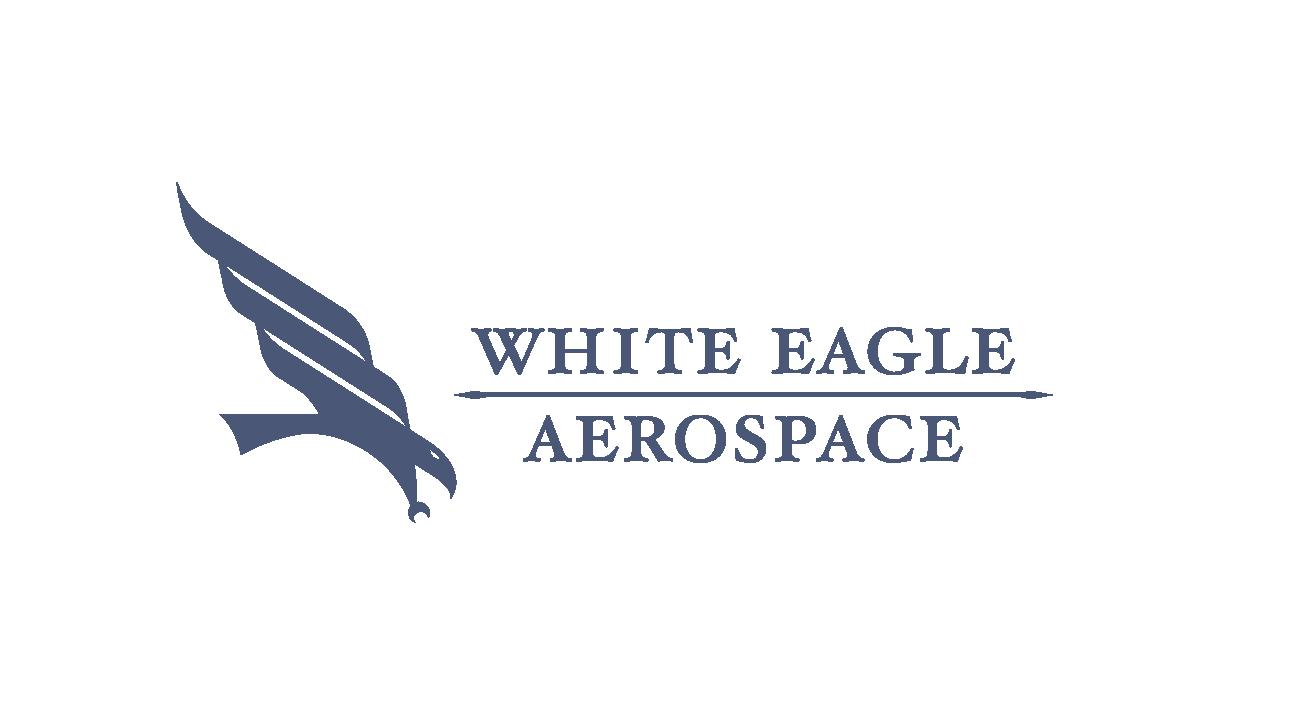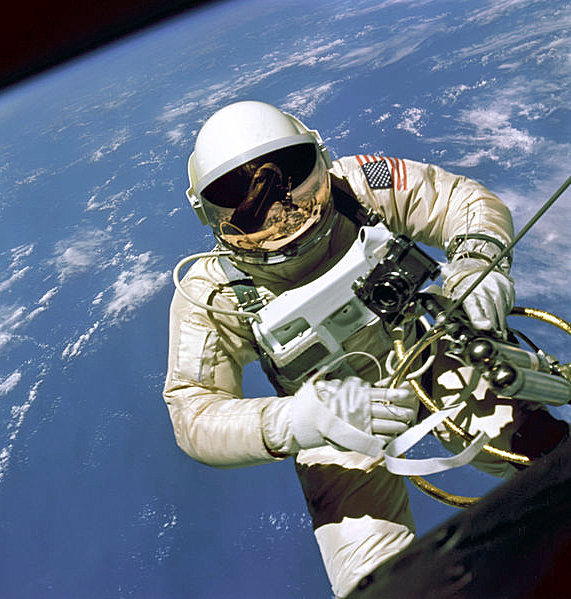
Fifty years ago today, Astronaut Edward H. White II became the first American to walk in space. Known in official NASA parlance as an Extra Vehicular Activity (EVA), White’s space feat took place during the historic 4-day mission of Gemini IV.
White, Mission Commander James A. McDivitt and their Gemini IV spacecraft were launched into low Earth orbit by a two-stage Titan II launch vehicle from LC-19 at Cape Canaveral Air Force Station, Florida. The mission clock started at 15:15:59 UTC on Thursday, 03 June 1965.
On the third orbit, less than five hours after launch, White opened the Gemini IV starboard hatch. He stood in his seat and mounted a camera to capture his historic space stroll. He then cast-off from Gemini IV and became a human satellite.
White was tethered to Gemini IV via a 15-foot umbilical that provided oxygen and communications to his EVA suit. A gold-plated visor on his helmet protected his eyes from the searing glare of the sun. The space-walking astronaut was also outfitted with a hand-held maneuvering unit that used compressed oxygen to power its small thrusters. And, like any good tourist, he also took along a camera.
Ed White had the time of his all-too-brief life in the 22 minutes that he walked in space. The sight of the earth, the spacecraft, the sun, the vastness of space, the freedom of movement all combined to make him exclaim at one point, “I feel like a million dollars!”.
Presently, it was time to get back into the spacecraft. But, couldn’t he just stay outside a little longer? NASA Mission Control and Commander McDivitt were firm. It was time to get back in; now! He grudgingly complied with the request/order, plaintively saying: “It’s the saddest moment of my life!”
As Ed White got back into his seat, he and McDivitt struggled to lock the starboard hatch. Both men were exhausted, but ebullient as they mused about the successful completion of America’s first space walk.
Gemini IV would eventually orbit the Earth 62 times before splashing-down in the Atlantic Ocean at 17:12:11 GMT on Sunday, 07 June 1965. The 4-day mission was another milestone in America’s quest for the moon.
The mission was over and yet Ed White was still a little tired. But then, that was really quite easy to understand. In the time that he was working outside the spacecraft, Gemini IV had traveled almost a third of the way around the Earth.
Now, that’s a long walk!
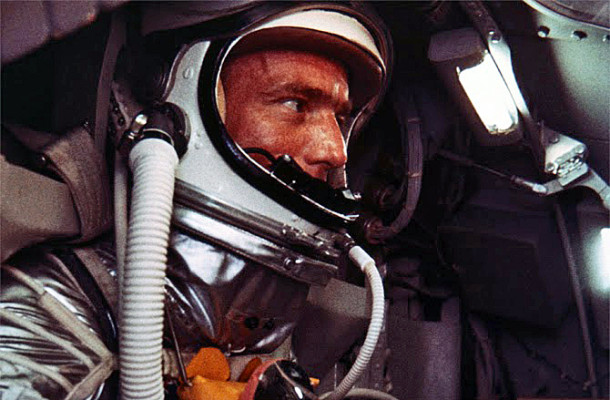
Fifty-three years ago this month, Mercury Astronaut M. Scott Carpenter orbited the Earth three times aboard his Aurora 7 Mercury spacecraft. In doing so, Carpenter became the second American to reach Earth orbit.
Project Mercury was America’s first manned spaceflight program. A total of six (6) flights took place between May of 1961 and May of 1963. The first two (2) flights were suborbital missions while the remainder achieved low Earth orbits. In February of 1962, John H. Glenn, Jr. became the first American to orbit the Earth during the Mercury-Atlas 6 (MA-6) mission.
Deke Slayton was to fly the Mercury-Atlas 7 (MA-7) mission. However, before that happened, the dreaded flight surgeon cabal grounded Slayton for what they deemed was a heart murmur. Despite Slayton’s utter incredulity and vehement protests, the decision held. Project Mercury officials maintained that the space program could ill afford the negative political fallout occasioned by the death of an astronaut on-orbit.
With Slayton grounded indefinitely, NASA selected Malcom Scott Carpenter to pilot the Mercury-Atlas 7 mission. Carpenter was member of the Original Seven selected by NASA for the Mercury Program in 1959. He was well prepared for the flight since he had just trained as Glenn’s MA-6 backup. As was the practice at that time, Carpenter named his Mercury spacecraft. The appellation he gave his celestial chariot was Aurora 7.
The launch of MA-7 took place on Thursday, 24 May 1962 from LC-14 at Cape Canaveral, Florida. Lift-off time was 12:45:16 UTC. Ascent performance of the stage-and-a-half Atlas D booster was nearly flawless as it inserted Aurora 7 into a 140-nm x 83-nm elliptical orbit. Having been cleared for at least 3 orbits, Carpenter quickly got down to the business of spaceflight.
Much of the activity on the first and second orbits involved Carpenter maneuvering his spacecraft, conducting scientific experiments and observing the Earth from space. Among other discoveries, he discerned that John Glenn’s mysterious “fireflies” were simply particles of ice and frost that had accumulated on the shadow side of the spacecraft. When the spacecraft structure was bumped or vibrated, these particles would disperse from the external surface of the spacecraft and float away into space. Once in the presence of strong sunlight, the particles appeared to glow or be luminescent.
A combination of the astronaut’s spacecraft maneuvering and an intermittently malfunctioning pitch horizon scanner left Carpenter with less than half of his maneuvering fuel left at the start of the third and final orbit. Carpenter compensated admirably by barely using his thrusters during Orbit 3. Indeed, nearing the time of retro-fire, Aurora 7 still had 40 percent of his fuel remaining in both the manual and automatic flight control systems.
As retro-fire approached, the intermittent pitch horizon scanner malfunction reappeared at a most inopportune moment. The automatic stabilization and control system suddenly would not hold Aurora 7 in the proper attitude for retro-fire; heatshield 34 degrees above the horizon at zero yaw angle. Carpenter subsequently switched to manual mode in an attempt to align the spacecraft properly for retro-fire.
When nominal time for retro-fire came, the retro-rockets did not automatically ignite. Carpenter had to do that manually. But he was 3 seconds late. Worst, Aurora 7 was still yawed 25 degree to the right. And to top it off, retro-thrust was 3 percent low. All of this meant that Aurora 7 would overshoot the nominal landing point by 215 nautical miles.
The trip down through the atmosphere was sporty in that Carpenter ran out of attitude control system fuel early during the descent. This meant that there was no means to propulsively damp the side-to-side oscillations that the Mercury spacecraft normally exhibited during reentry. These oscillations became dangerous when they exceeded about 10 degrees. That is, the spacecraft could tumble end-over-end if left unchecked.
Carpenter simultaneously eyed the altimeter and spacecraft angle-of-attack. As the latter built-up dangerously, his only recourse was to manually fire the drogue earlier than planned in attempt to arrest Aurora 7’s oscillatory motion. He did so at 25,000 feet. The spacecraft’s side-to-side oscillations were stopped. Carpenter then deployed his main parachute at 9,500 feet. Splashdown occurred at 17:41:21 UTC at a point 108 nautical miles northeast of Puerto Rico.
Since Aurora 7 was listing badly and help was about an hour away, Carpenter extricated himself from the spacecraft and deployed his life raft. While a radio beacon helped recovery forces locate him, there was no voice communication between the astronaut and his rescuers. Carpenter was on the surface of the briny deep nearly 3 hours before being picked-up by rescue helicopters and safely delivered to the carrier USS Intrepid. Some six (6) hours later, Aurora 7 was brought onboard the USS John R. Pierce.
Mercury-Atlas 7 was Scott Carpenter’s only space mission. A combination of factors, including less than amicable relations with Mercury Mission Control management, led to this being the case. During the intervening years, many stories alluding to pilot error or inattention as the cause of Aurora 7’s landing overshoot have been circulated. Indeed, much like Gus Grissom’s experience with the loss of his Liberty Bell spacecraft, these stories and explanations have been around long enough that they are now accepted as the “truth”.
Criticism of another’s performance comes easily in this world. However, as Theodore Roosevelt once pointed out, it really is “The Man in the Arena” who counts most. It is he and he alone who faces and reacts to the actual moment of trial. No one but he knows the utter reality of that moment and the vicissitudes thereof. While others may criticize, we go on record here to acknowledge and honor M. Scott Carpenter for his heroic and pioneering contributions to early American manned spaceflight.
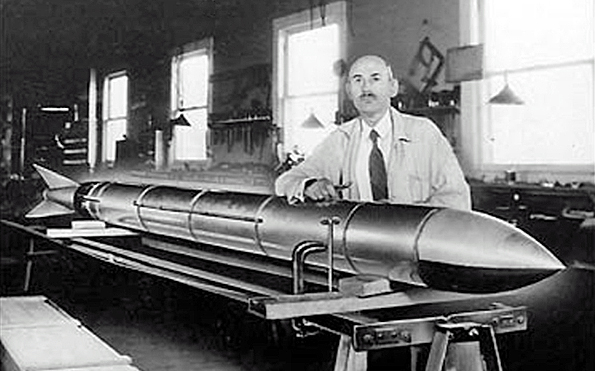
Eighty years ago this month, pioneering rocket scientist Robert H. Goddard and staff fired a liquid-fueled rocket to a record altitude of 7,500 feet above ground level. The record-setting flight took place at Roswell, New Mexico.
Robert Hutchings Goddard was born in Worcester, Massachusetts on Thursday, 05 October 1882. He was enamored with flight, pyrotechnics, rockets and science fiction from an early age. By the time he was 17, Goddard knew that his life’s work would combine all of these interests.
Goddard was a sickly youth, but spent his well moments as a voracious reader of all manner of science-oriented literature. He graduated in 1904 from South High School in Worcester as the valedictorian of his class. He matriculated at Worcester Polytechnic and graduated with a Bachelor of Science degree in physics in 1908. A Master of Science degree and Ph.D. from Worcester’s Clark University followed in 1910 and 1911, respectively.
Goddard spent the next eight years of his life working on numerous propulsion and rocket-related projects. Then, in 1919, he published his now-famous scientific treatise entitled A Method of Reaching Extreme Altitudes. In that paper, the press glommed on to Goddard’s passing mention that a multi-staged rocket could conceivably fly all the way to the Moon.
Goddard was roundly ridiculed for his fanciful prognostications about Moon flight. The New York Times was especially derogatory in its estimation of Goddard’s ideas and accused him of junk science. A Times editorial even criticized Goddard for his “misconception” that a rocket could produce thrust in the vacuum of space.
Even the United States government largely ignored Goddard. The negative treatment to which Goddard was subjected profoundly affected the American rocket scientist. So much so that he spent the remainder of his life completely alienated from the scorning dolts of both media and government.
Despite the blow to his professional reputation, Goddard resolutely pressed on with his rocket research. Indeed, after more that five years of intense development effort, Goddard and his staff launched the first liquid-fueled rocket on Tuesday, 16 March 1926 in Auburn, Massachusetts. The flight duration was short (2.5 seconds) and the peak altitude tiny (41 feet), but Goddard proved that liquid rocket propulsion was feasible.
Goddard’s liquid-fueled rocket testing would ultimately lead him from the countryside of New England to the desert of the Great South West. With financial support from Harry Guggenheim and the public backing of Charles Lindbergh, Goddard transfered his testing activities to Roswell, New Mexico in 1930. He would continue liquid-fueled rocket testing there until May 1941.
On Friday, 31 May 1935, experimental rocket flight A-8 took to the air from Goddard’s Roswell, New Mexico test site at 1430 UTC. Roughly 15 feet in length and weighing approximately 90 pounds at lift-off, the 9-inch diameter A-8 achieved a maximum altitude of 7,500 feet (1.23 nautical miles) above the desert floor. Only a flight in March of 1937 would go higher (9,000 feet).
Robert Goddard was ultimately credited with 214 U.S. patents for his rocket development work. Only 83 were awarded in his life time. His far-reaching inventions included rocket nozzle design, regenerativley cooled rocket engines, turbopumps, thrust vector controls, gyroscopic control systems and more.
Goddard died at the age of 62 from throat cancer in Baltimore, Maryland on Friday, 10 August 1945. Many years would pass before the full import of his accomplishments was comprehended. Then, the posthumously-bestowed recognition came in torrents. In 1959, Congress issued a special gold medal in Goddard’s honor. The Goddard Spaceflight Center was so named by NASA in 1959 as well. Many more such bestowals followed.
Perhaps the most meaningful of the recognitions ever accorded Robert Hutchings Goddard occurred 24 years after his passing. It was in connection with the first manned lunar landing in July of 1969. And it was poetic not only in terms of its substance and timing, but more particularly in light of the source from whence the recognition came.
A terse statement in the New York Times corrected a long-standing injustice. It read: “Further investigation and experimentation have confirmed the findings of Issac Newton in the 17th century, and it is now definitely established that a rocket can function in a vaccum as well as in an atmosphere. The Times regrets the error.”
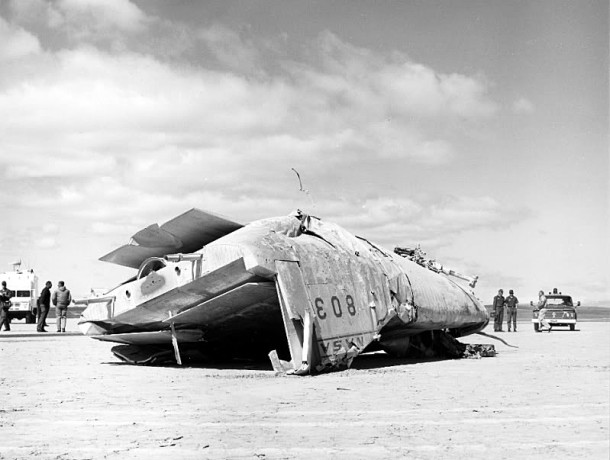
Forty-eight years ago this week, NASA’s experimental M2-F2 lifting body flight research aircraft was demolished in a horrific landing mishap on Rogers Dry Lake at Edwards Air Force Base. Although critically injured, NASA test pilot Bruce A. Peterson survived the mishap.
A lifting body is a wingless aircraft wherein the aerodynamic lift required for flight is derived solely from the fuselage. Interest in such a configuration stems from the type’s inherent suitability for lifting atmospheric entry from space. The primary attributes of same being favorable cross-range capability and aerodynamic heating performance.
Lifting body concepts date back to at least the 1950’s. From 1963 to 1975, both NASA and the United States Air Force conducted a number of manned lifting body flight research programs. The aircraft involved were the M2-F1, M2-F2, M2-F3, HL-10, X-24A and X-24B. All were flown out of Edwards Air Force Base between 1963 and 1975.
The favorable hypersonic flight performance of lifting bodies comes at a price. Specifically, lifting bodies are not particularly good subsonic aircraft from the standpoint of lateral-directional handling qualities. The type also falls like a rock in the approach and landing phase. Due to characteristically-low values of subsonic lift-to-drag ratio, touchdown speeds can exceed 250 knots.
The M2-F2 was the first of the heavy weight lifting bodies. It measured 22 feet in length and 9.4 feet in span. The aircraft had an empty weight of 4,630 pounds. The M2-F2 had boosted hydraulic 3-axis flight controls and a stability augmentation system. The vehicle was also configured with a quartet of hydrogen peroxide rockets rated at 400 pounds of thrust each.
On Wednesday, 10 May 1967, the M2-F2 (NASA S/N 803) fell away from the fabled B-52B (S/N 52-0008) launch aircraft at an altitude of 44,000 feet. NASA test pilot Bruce A. Peterson was at the controls of the M2-F2. This was Peterson’s 3rd flight in the M2-F2 and the aircraft’s 16th overall. It would be the last research flight for both man and machine.
The early part of the mission was unremarkable. Then the flight test gremlins made their presence known. Passing through 7,000 feet in a steep glide, Peterson pushed forward on the control column and brought the M2-F2 to quasi-zero angle-of-attack. The aircraft quickly entered a Dutch Roll which resulted in extreme, rapid lateral excusions.
Peterson increased angle-of-attack to arrest the wild lateral-directional motions of the M2-F2. However, he was no longer pointed toward Runway 18 on Rogers Dry Lake as intended. The ground was coming up rapidly and he would have to land the M2-F2 on a part of the lakebed that did not have the typical visual aids required for correctly judging height above surface level.
Peterson might have gotten himself and the M2-F2 on the ground in one piece except for the helicopter that now loomed directly ahead in his landing path. Not that it was the helicopter pilot’s fault. It was just that the M2-F2 had strayed so far from its intended flight path that the helicopter was suddenly a navigational hazard.
Managing to somehow avoid a collision with the flight support helicopter, Peterson now fired his landing rockets in an attempt to stay in the air a little longer. He then hit the landing gear switch. In 1.5 seconds the gear would be down and locked. Unfortunately for Peterson, there was only one second of flight time remaining before touchdown.
As the M2-F2 contacted the lakebed at 220 knots, its main landing gear was jammed back up into the fuselage. That was the end of the ball game. Sickeningly, the M2-F2 tumbled end-over-end across Rogers Dry Lake shearing off the canopy, main gear and right vertical tail. The battered and twisted airframe finally came to rest inverted on the ancient lakebed.
Incredibly, rescue crews found Bruce Peterson still alive as they came upon the crash scene. He was even conscious. However, the pilot was terribly hurt. Peterson’s oxygen mask had been torn off as the M2-F2 tumbled six (6) times before coming to a stop. He received severe facial injuries due to repeated impact with the lakebed surface. In addition, Peterson suffered a fractured skull, severe damage to his right eye and a broken hand.
Bruce Peterson came back from his brush with eternity. He needed extensive reconstructive surgery on his face and lost the sight in his right eye. Peterson served as a project engineer for a number of NASA flight programs and even flew as a Marine reservist. He later served as a safety officer on the B-2 flight test effort. Bruce Peterson passed away at the age of 72 on 01 May 2006.
For those who remember, “The Six-Million-Dollar Man” was a television series about a fictional test pilot who had been badly injured in an aircraft accident. In the storyline, the fictional character was “rebuilt” by doctors using bionic technology. Trivia buffs may be interested to know that the basis for “The Six-Million-Dollar Man” was Bruce Peterson’s M2-F2 experience.
For those that remember, the “The Six-Million-Dollar Man” was a televison series about a fictional test pilot who had been badly injured in an aircraft accident. In the storyline, the fictional character was “rebuilt” by doctors using bionic technology. Trivia buffs may be interested to know that the basis for “The Six-Million-Dollar Man” was Bruce Peterson’s terrifying M2-F2 crash.
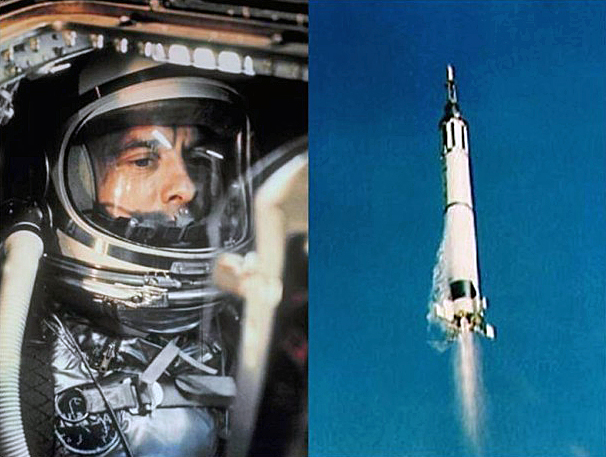
Fifty-four years ago today, United States Navy Commander Alan Bartlett Shepard, Jr. became the first American to be launched into space. Shepard named his Mercury spacecraft Freedom 7.
Officially designated as Mercury-Redstone 3 (MR-3) by NASA, the mission was America’s first true attempt to put a man into space. MR-3 was a sub-orbital flight. This meant that the spacecraft would travel along an arcing parabolic flight path having a high point of about 115 nautical miles and a total range of roughly 300 nautical miles. Total flight time would be about 15 minutes.
The Mercury spacecraft was designed to accommodate a single crew member. With a length of 9.5 feet and a base diameter of 6.5 feet, the vehicle was less than commodious. The fit was so tight that it would not be inaccurate to say that the astronaut wore the vehicle. Suffice it to say that a claustrophobic would not enjoy a trip into space aboard the spacecraft.
Despite its diminutive size, the 2,500-pound Mercury spacecraft (or capsule as it came to be referred to) was a marvel of aerospace engineering. It had all the systems required of a space-faring craft. Key among these were flight attitude, electrical power, communications, environmental control, reaction control, retro-fire package, and recovery systems.
The Redstone booster was an Intermediate Range Ballistic Missile (IRBM) modified for the manned mission. The Redstone’s uprated A-7 rocket engine generated 78,000 pounds of thrust at sea level. Alcohol and liquid oxygen served as propellants. The Mercury-Redstone combination stood 83 feet in length and weighed 66,000 pounds at lift-off.
On Friday, 05 May 1961, MR-3 lifted-off from Cape Canaveral’s Launch Complex 5 at 14:34:13 UTC. Alan Shepard went to work quickly calling out various spacecraft parameters and mission events. The astronaut would experience a maximum acceleration of 6.5 g’s on the ride upstairs.
Nearing apogee, Shepard manually controlled Freedom 7 in all 3 axes. In doing so, he positioned the capsule in the required 34-degree nose-down attitude. Retro-fire occurred ontime and the retro package was jettisoned without incident. Shepard then pitched the spacecraft nose to 14 degrees above the horizon in preparation for reentry back into the earth’s atmosphere.
Reentry forces quickly built-up on the plunge back into the atmosphere with Shepard enduring a maximum deceleration of 11.6 g’s. He had trained for more than 12 g’s prior to flight. At 21,000 feet, a 6-foot droghue chute was deployed followed by the 63-foot main chute at 10,000 feet. Freedom 7 splashed-down in the Atlantic Ocean 15 minutes and 28 seconds after lift-off.
Following splashdown, Shepard egressed Freedom 7 and was retreived from the ocean’s surface by a recovery helicopter. Both he and Freedom 7 were safely onboard the carrier USS Lake Champlain within 11 minutes of landing. During his brief flight, Shepard had reached a maximum speed of 5,180 mph, flown as high as 116.5 nautical miles and traveled 302 nautical miles downrange.
The flight of Freedom 7 had much the same effect on the Nation as did Lindbergh’s solo crossing of the Atlantic in 1927. However, in light of the Cold War fight against the world-wide spread of Soviet communism, Shepard’s flight arguably was more important. Indeed, Alan Shepard became the first of what Tom Wolfe called in his classic book The Right Stuff, the American single combat warrior.
For his heroic MR-3 efforts, Alan Shepard was awarded the Distinguished Service Medal by an appreciative nation. In February 1971, Alan Shepard walked on the surface of the Moon as Commander of Apollo 14. He was the lone member of the original Mercury Seven astronauts to do so. Shepard was awarded the Congressional Space Medal of Freedom in 1978.
Alan Shepard succumbed to leukemia in July of 1998 at the age of 74. In tribute to this American space hero, naval aviator and US Naval Academy graduate, Alan Shepard’s Freedom 7 spacecraft now resides in a place of honor at the United States Naval Academy in Annapolis, Maryland.
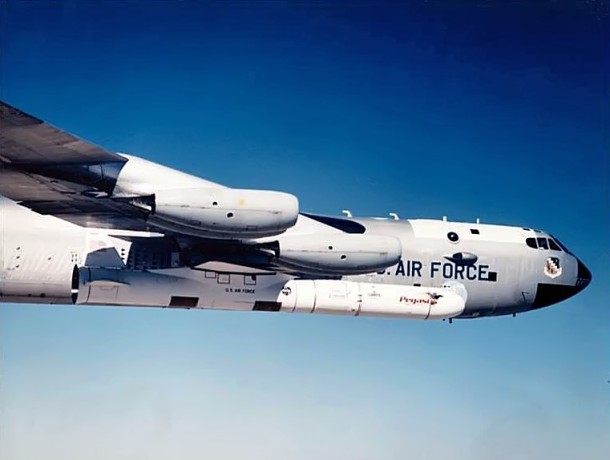
Twenty-five years ago this month, the Orbital Sciences Corporation (OSC) orbited a PegSat satellite using the then-new Pegasus 3-stage launch vehicle. This historic event marked the first successful implementation of the air-launched satellite launcher concept.
The concept of air-launch dates back to the 1940’s and the early days of United States X-plane flight research. A multi-engine aircraft known as the mothership was employed to transport a smaller test aircraft to altitude. The test aircraft was subsequently dropped from the mothership and went on to conduct the flight research mission.
A clear benefit of air-launch was that all of the fuel and propulsion required to get to the drop point was provided by the mothership. Thus, the test aircraft was allowed to use all of its own fuel for the flight research mission proper. In that sense, the mothership-test aircraft combination functioned as a two-stage launch vehicle.
The value and efficacy of the air-launch concept was demonstrated on numerous X-plane programs. Flight research aircraft such as the Bell XS-1, Bell X-1A, Bell X-1E, Bell X-2, Douglas D-558-II, and North American X-15 were all air-launched. More recently, the X-43A and X-51A scramjet-powered flight research vehicles also employed the air-launch concept.
An added benefit of the air-launch technique is that the launch site is highly portable! This provides enhanced mission flexibility compared to fixed position launch sites. The associated operating costs are much lower for the air-launched concept as well.
Orbital Science’s original Pegasus launch vehicle configuration was designed to fit within the dimensional envelope of the X-15. The standard Pegasus configuration measured 50 feet in length and had a wingspan of 22 feet. The same dimensions as the baseline X-15 rocket airplane. Pegasus body diameter and launch weight were 50 inches and 41,000 pounds, respectively.
A key design feature of the Pegasus 3-stage launch vehicle configuration was the vehicle’s trapezodal-planform wing which provided the aerodynamic lift required to shape the endoatmospheric portion of the ascent flight path. This made Pegasus even more X-15-like.
The real difference between Pegasus and the X-15 was propulsion. The X-15 performed a sub-orbital mission using an XLR-99 liquid rocket engine rated at 57,000 pounds of sea level thrust. Pegasus used a combination of three (3) Hercules solid rocket motors to perform an orbital mission. The 1st, 2nd and 3rd stage rocket motors were rated at 109,000, 26,600 and 7,800 pounds of vacuum thrust, respectively.
On Thursday, 05 April 1990, the first Pegasus launch took place over the Pacific Ocean within an area known as the Point Arguello Western Air Drop Zone (WADZ). Pegasus 001 fell away from its NASA B-52B (S/N 52-0008) mothership at 19:10 UTC as the pair flew at Mach 0.8 and 43,000 feet. Pegasus first stage ignition took place 5 seconds after drop.
Following first stage ignition, the Pegasus executed a pull-up to begin the trip upstairs. The second and third stage rocket motors fired on time. The stage separation and payload fairing jettison events worked as planned. Roughly 10 minutes after drop, the 392-pound PegSat payload arrived in a 315 mile x 249 mile elliptical orbit.
Since that triumphant day in April 1990, both the Pegasus launch vehicle configuration and mission have grown and matured. Of a total of 42 official Pegasus missions to date, 39 have been flown successfully.
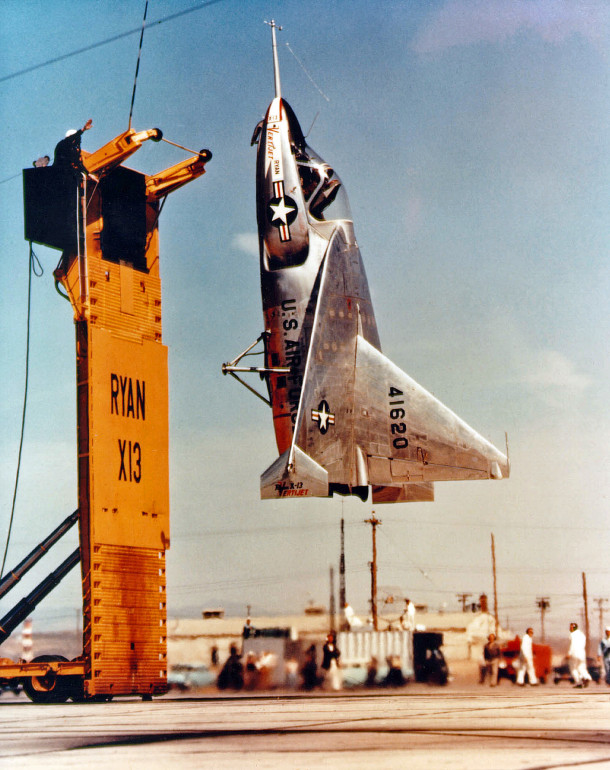
Fifty-eight years ago this month, the USAF/Ryan X-13 Vertijet completed history’s first vertical-to horizontal-back to vertical flight of a jet-powered Vertical Take-Off and Landing (VTOL) aircraft. This event took place at Edwards Air Force Base, California with Ryan Chief Test Pilot Peter F. Girard at the controls.
The X-13 Vertijet was an experimental flight vehicle designed to determine the feasibility of a jet-powered Vertical Take-Off and Landing (VTOL) aircraft. The initial idea for the type dates back to 1947 when the United States Navy (USN) put Ryan under contract to explore the viability of a jet-powered VTOL aircraft. At the time, the Navy was quite interested in exploiting the VTOL concept for tactical advantage. The service envisioned basing VTOL aircraft on submarines and small surface ships.
The USN-Ryan team worked the X-13 VTOL concept for over six (6) years to good effect. While no flight vehicle took to the skies during that time, a great deal of progress was made in the realm of hovering flight using ground-based vertical test rigs. Particular effort was focused on VTOL low-speed flight controls. However, Navy research and development funding was slashed in the aftermath of the Korean War and the X-13 project ran out of money in the summer of 1953.
Fortunately, the United States Air Force (USAF) had become interested in the X-13 and the possibilities of VTOL flight prior to the Navy running out of money. The junior service assumed ownership of the X-13 effort after securing the funding required to continue the program. A pair of X-13 prototypes were subseqently built and flown by Ryan Aeronautical. These aircraft were assigned USAF serial numbers 54-1619 and 54-1620, respectively.
The X-13 measured 23.5 feet in length and had a wing span of 21 feet. The single-place aircraft featured a maximum take-off weight of approximately 7,300 pounds. Hovering flight control was provided via wing tip-mounted yaw and roll nozzles. The heart of the VTOL aircraft was its reliable Rolls-Royce Avon turbojet. The non-afterburning powerplant used standard JP-4 fuel and produced a maximum thrust of 10,000 pounds.
The X-13 was transported, launched and retrieved using a special flatbed trailer. Hinged at one end, the trailer was raised and lowered through the instrumentality of a pair of hydraulic rams. Once raised to a vertical position, the X-13 hung on its nose hook from a steel suspension cable stretched between two mechanical arms. Rather than landing gear, the aircraft sat on two non-retractable tubular bumpers positioned on the lower fuselage.
Flight testing of the No. 1 X-13 (S/N 54-1619) began on Saturday, 10 December 1955 at Edwards Air Force Base, California. The purpose of this initial flight was to test the X-13’s conventional flight characteristics. The aircraft was configured with tricycle landing to permit a runway take-off. Ryan Chief Test Pilot Peter F. “Pete” Girard flew a brief seven minute test hop in which he determined that the X-13 had serious control issues in all 3-axes. The subsequent installation of yaw and roll dampers fixed the problem.
The next phase of flight testing involved vertical hovering flight wherein aircraft handling and control characteristics were explored. For doing so, the X-13 was outfitted with a vertical landing gear system composed of a tubular support structure and a quartet of small caster-type wheels. Thus configured, the X-13 could take-off, hover and land in the vertical. As vertical flight testing progresed, important refinements were made to the aircraft’s turbojet throttling and reaction control systems.
The first vertical flight test was made on Monday, 28 May 1956 with the No. 1 aircraft. Pete Girard was again in the cockpit. Restricting maximum altitude to about 50 feet above ground level, Girard found the aircraft relatively easy to fly and land. Succeeding flight tests would ultimately include practice hook landings wherein a 1-inch thick manila rope suspended between a pair of 50-foot towers was engaged. A great deal of experience with and confidence in the X-13 system was accrued during these tests.
Prior to flying the X-13 all-up mission, an additional phase of flight testing was required which would culminate with the events of Monday, 28 November 1956. With the conventional landing gear installed on the No. 1 aircraft, Girard took-off from Edwards and climbed to 6,000 feet. He then slowly pitched the aircraft into the vertical and hovered for an extended period. Girard then executed a transition back to horizontal flight and landed. The first-ever horizontal-to vertical-back to horizontal flight transition was entirely successful.
The big day came on Thursday, 11 April 1957. Edwards Air Force Base again served as the test site. This time using the No. 2 X-13 (S/N 54-1620), Pete Girard took-off vertically, ascended in hovering flight and transitioned to conventional flight. Following a series of standard flight maneuevers, Girard transitioned the aircraft back into a vertical hover, descended and engaged the suspension cable on the support trailer with the aircraft’s nose hook. The first-ever vertical-to horizontal-back to vertical flight of a jet-propelled VTOL aircraft was history.
Both X-13 aircraft would go on to successfully conduct additional flight testing and stage numerous flight demonstrations during the remainder of 1957. However, innovative and impressive as it was, the X-13 did not garner the advocacy and backing required to proceed to production. A combination of bad timing, a risk averse military and combat performance limitations resulted in the aircraft and its technology quickly fading from the aviation scene.
Remarkably, both X-13 aircraft survived the type’s flight test program. The No. 1 aircraft (S/N 54-1619) is displayed at the San Diego Aerospace Museum in San Diego, California. The No. 2 X-13 aircraft (S/N 54-1620) is on display in the Research and Development Gallery of the United States Air Force Museum at Wright-Patterson Air Force Base in Dayton, Ohio.
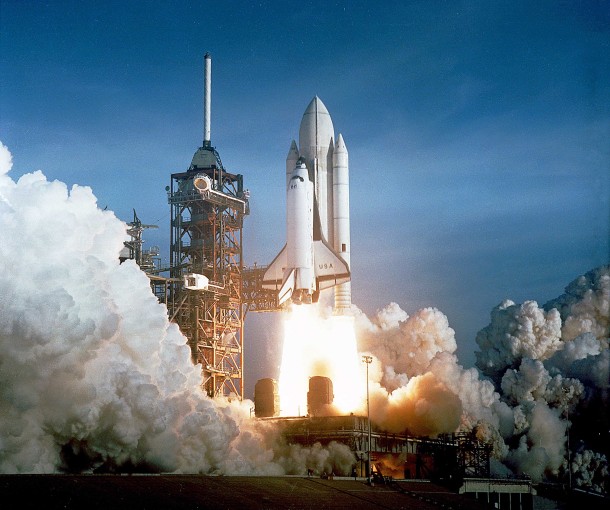
Thirty-four years ago this month, the United States successfully launched the Space Shuttle Columbia into orbit about the Earth. It was the maiden flight of the Nation’s Space Transportation System (STS).
The Space Shuttle was unlike any manned space vehicle ever flown. A giant aircraft known as the Orbiter was side-mounted on a huge liquid-propellant stage called the External Tank (ET). Flanking opposing sides of the ET was a pair of Solid Rocket Boosters (SRB). The Orbiter, SRB’s and ET measured 122 feet, 149 feet and 154 feet in length, respectively.
The Space Shuttle system was conceived with an emphasis on reusability. Each Orbiter (Columbia, Challenger, Atlantis, Discovery and Endeavor) was designed to fly 100 missions. Each SRB was intended for multiple mission use as well. The only single-use element was the ET since it was more cost effective to use a new one for each flight than to recover and refurbish a reusable version.
NASA called STS-1 the boldest test flight in history. Indeed, the STS-1 mission marked the first time that astronauts would fly a space vehicle on its inaugural flight! STS-1 was also the first time that a manned booster system incorporated solid rocket propulsion. Unlike liquid propellant rocket systems, once ignited, the Shuttle’s solid rockets burned until fuel exhaustion.
And then there was the Orbiter element which had its own new and flight-unproven propulsion systems. Namely, the Space Shuttle Main Engines (SSME) and Orbital Maneuvering System (OMS). Each of the three (3) SSME’s generated 375,000 pounds of thrust at sea level. Thrust would increase to 475,000 pounds in vacuum. Each OMS rocket engine produced 6,000 pounds of thrust in vacuum.
The Orbiter was also configured with a reusable thermal protection system (TPS) which consisted of silica tiles and reinforced carbon-carbon material. The TPS for all previous manned space vehicles utilized single-use ablators. Would the new TPS work? How robust would it be in flight? What post-flight care would be needed? Answers would come only through flight.
To add to the “excitement” of first flight, the Orbiter was a winged vehicle and would therefore perform a hypersonic lifting entry. The vehicle energy state would have to be managed perfectly over the 5,000 mile reentry flight path from entry interface to runway touchdown. Since the Orbiter flew an unpowered entry, it would land dead-stick. There would only be one chance to land.
On Sunday,12 April 1981, the Space Shuttle Columbia lifted-off from Pad 39A at Cape Canaveral, Florida. Official launch time was 12:00:03 UTC. The flight crew consisted of Commander John W. Young and Pilot Robert L. Crippen. Their Columbia launch stack tipped the scales at 4.5 million pounds and thundered away from the pad on over 7 million pounds of thrust.
Columbia went through maximum dynamic pressure (606 psf) at Mach 1.06 and 26.5 KFT. SRB separation occurred 120 seconds into flight at Mach 3.88 and 174,000 feet; 10,000 feet higher than predicted. This lofting of the ascent trajectory was later attributed to unmodeled plume-induced aerodynamic effects in the Orbiter and ET base region.
Following separation, Columbia rode the ET to burnout at Mach 21 and 389.7 KFT. Following ET separation, Columbia’s OMS engines were fired minutes later to achieve a velocity of 17,500 mph and a 166-nautical mile orbit.
Young and Crippen would orbit the Earth 37 times before coming home on Tuesday, 14 April 1981. In doing so, they successfully flew the first hypersonic lifting reentry from orbit. Though unaware of it at the time, the crew came very close to catastrophe as the Orbiter’s body flap had to be deflected 8 degrees more than predicted to maintain hypersonic pitch control.
The reason for this hypersonic anomaly was that ground test and aero modeling had failed to accurately capture the effects of high temperature gas dynamics on Orbiter pitch aerodynamics. Specifically, the vehicle was more stable in hypersonic flight than had been predicted. This necessitated greater nose-down body flap deflections to trim the vehicle in pitch. It was a close-call. But Columbia and its crew lived to fly another day.
Columbia touched-down at 220 mph on Runway 23 at Edwards Air Force Base, California at 18:20:57 UTC. Young and Crippen were euphoric with the against-the-odds success of the Space Shuttle’s first mission.
NASA too reveled in the Shuttle’s accomplishment. And so did America. This was the country’s first manned space mission since 1975. The longest period of manned spaceflight inactivity ever in the Nation’s history.
Fittingly, a well-known national news magazine celebrated Columbia’s success with a headline which read: “America is Back!”
And while it flies no more, we remember that first Orbiter, its first flight and its many subsequent accomplishments. To which we say: Hail Columbia!
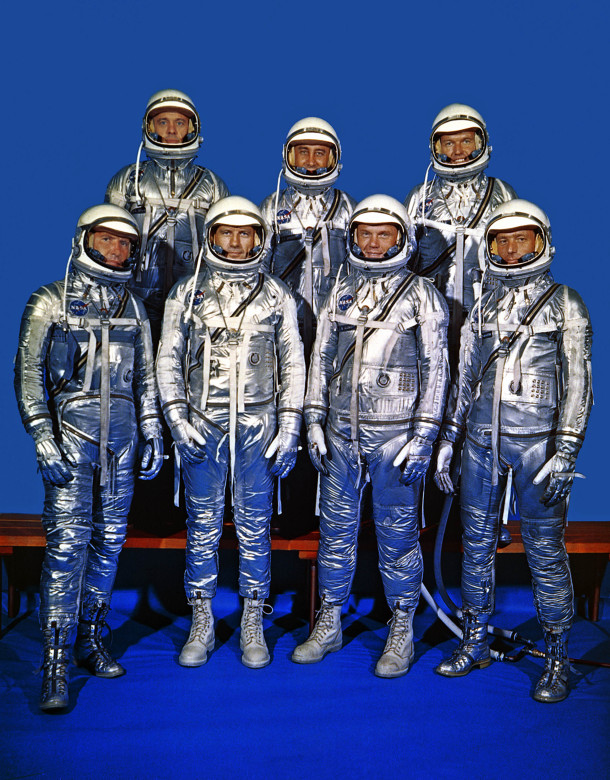
Fifty-six years ago this week, NASA held a press conference in Washington, D.C. to introduce the seven men selected to be Project Mercury Astronauts. They would become known as the Mercury Seven or Original Seven.
Project Mercury was America’s first manned spaceflight program. The overall objective of Project Mercury was to place a manned spacecraft in Earth orbit and bring both man and machine safely home. Project Mercury ran from 1959 to 1963.
The men who would ultimately become Mercury Astronauts were among a group of 508 military test pilots originally considered by NASA for the new role of astronaut. The group of 508 candidates was then successively pared to 110, then 69 and finally to 32. These 32 volunteers were then subjected to exhaustive medical and psychological testing.
A total of 18 men were still under consideration for the astronaut role at the conclusion of the demanding test period. Now came the hard part for NASA. Each of the 18 finalists was truly outstanding and would be a worthy finalist. But there were only 7 spots on the team.
On Thursday, 09 April 1959, NASA publicly introduced the Mercury Seven in a special press conference held for this purpose at the Dolley Madison House in Washington, D.C. The men introduced to the Nation that day will forever hold the distinction of being the first official group of American astronauts. In the order in which they flew, the Mercury Seven were:
Alan Bartlett Shepard Jr., United States Navy. Shepard flew the first Mercury sub-orbital mission (MR-3) on Friday, 05 May 1961. He was also the only Mercury astronaut to walk on the Moon. Shepherd did so as Commander of Apollo 14 (AS-509) in February 1971. Alan Shepard died from leukemia on 21 July 1998 at the age of 74.
Vigil Ivan Grissom, United States Air Force. Grissom flew the second Mercury sub-orbital mission (MR-4) on Friday, 21 July 1961. He was also Commander of the first Gemini mission (GT-3) in March 1965. Gus Grissom might very well have been the first man to walk on the Moon. But he died in the Apollo 1 Fire, along with Astronauts Edward H. White II and Roger Chaffee, on Friday, 27 January 1967. Gus Grissom was 40 at the time of his death.
John Herschel Glenn Jr., United States Marines. Glenn was the first American to orbit the Earth (MA-6) on Thursday, 22 February 1962. He was also the only Mercury Astronaut to fly a Space Shuttle mission. He did so as a member of the STS-95 crew in October of 1998. Glenn was 77 at the time and still holds the distinction of being the oldest person to fly in space. John Glenn will be 94 in July 2015.
Malcolm Scott Carpenter, United States Navy. Carpenter became the second American to orbit the Earth (MA-7) on Thursday, 24 May 1962. This was his only mission in space. Carpenter subsequently turned his attention to under-sea exploration and was an aquanaut on the United States Navy SEALAB II project. Scott Carpenter died in October 2013 shortly after suffering a stroke. He was 88 at the time of his passing.
Walter Marty Schirra Jr., United States Navy. Schirra became the third American to orbit the Earth (MA-8) on Wednesday, 03 October 1962. He later served as Commander of Gemini 6A (GT-6) in December 1965 and Apollo 7 (AS-205) in October 1968. Schirra was the only Mercury Astronaut to fly Mercury, Gemini and Apollo space missions. Wally Schirra died from a heart attack in May 2007 at the age of 84.
Leroy Gordon Cooper Jr., United States Air Force. Cooper became the fourth American to orbit the Earth (MA-9) on Wednesday, 15 May 1963. In doing so, he flew the last and longest Mercury mission (22 orbits, 34 hours). Cooper was also Commander of Gemini 5 (GT-5), the first long-duration Gemini mission, in August 1965. Gordo Cooper died from heart failure in October 2004 at the age of 77.
Donald Kent Slayton, United States Air Force. Slayton was the only Mercury Astronaut to not fly a Mercury mission when he was grounded for heart arrythemia in 1962. He subsequently served many years on Gemini and Apollo as head of astronaut selection. He finally got his chance for spaceflight in July 1975 as a crew member of the Apollo-Soyuz mission (ASTP). Deke Slayton died from brain cancer in June of 1993 at the age of 69.
History records that the Mercury Seven was the only group of NASA astronauts that had a member that flew each of America’s manned spacecraft (i.e, Mercury, Gemini, Apollo and Shuttle). Though just men and imperfect mortals, we honor and remember them for their genuinely heroic deeds and unique contributions made to the advancement of American manned spaceflight.
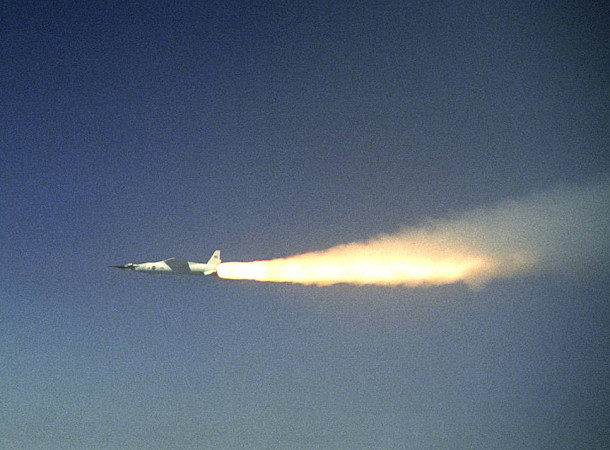
Eleven years ago this month, the NASA X-43A scramjet-powered flight research vehicle reached a record speed of over 4,600 mph (Mach 6.83). The test marked the first time in the annals of aviation that a flight-scale scramjet accelerated an aircraft in the hypersonic Mach number regime.
NASA initiated a technology demonstration program known as HYPER-X in 1996. The fundamental goal of the HYPER-X Program was to successfully demonstrate sustained supersonic combustion and thrust production of a flight-scale scramjet propulsion system at speeds up to Mach 10.
Also known as the HYPER-X Research Vehicle (HXRV), the X-43A aircraft was a scramjet test bed. The aircraft measured 12 feet in length, 5 feet in width, and weighed nearly 3,000 pounds. The X-43A was boosted to scramjet take-over speeds with a modified Orbital Sciences Pegasus rocket booster.
The combined HXRV-Pegasus stack was referred to as the HYPER-X Launch Vehicle (HXLV). Measuring approximately 50 feet in length, the HXLV weighed slightly more than 41,000 pounds. The HXLV was air-launched from a B-52 mothership. Together, the entire assemblage constituted a 3-stage vehicle.
The second flight of the HYPER-X program took place on Saturday, 27 March 2004. The flight originated from Edwards Air Force Base, California. Using Runway 04, NASA’s venerable B-52B (S/N 52-0008) started its take-off roll at approximately 20:40 UTC. The aircraft then headed for the Pacific Ocean launch point located just west of San Nicholas Island.
At 21:59:58 UTC, the HXLV fell away from the B-52B mothership. Following a 5 second free fall, rocket motor ignition occurred and the HXLV initiated a pull-up to start its climb and acceleration to the test window. It took the HXLV about 90 seconds to reach a speed of slightly over Mach 7.
Following HXLV rocket motor burnout and a brief coast period, the HXRV (X-43A) successfully separated from the Pegasus booster at 94,069feet and Mach 6.95. The HXRV scramjet engine was operative by Mach 6.83. Supersonic combustion and thrust production were successfully achieved. The total engine-on duration was approximately 11 seconds.
As the X-43A decelerated along its post-burn descent flight path, the aircraft performed a series of data gathering flight maneuvers. A vast quantity of high-quality aerodynamic and flight control system data were acquired for Mach numbers ranging from hypersonic to transonic. Finally, the X-43A impacted the Pacific Ocean at a point about 450 nautical miles due west of its launch location. Total flight time was approximately 15 minutes.
The HYPER-X Program made history that day in late March 2004. Supersonic combustion and thrust production of an airframe-integrated scramjet were achieved for the first time in flight; a goal that dated back to before the X-15 Program. Along the way, the X-43A established a speed record for airbreathing aircraft and earned a Guinness World Record for its efforts.











